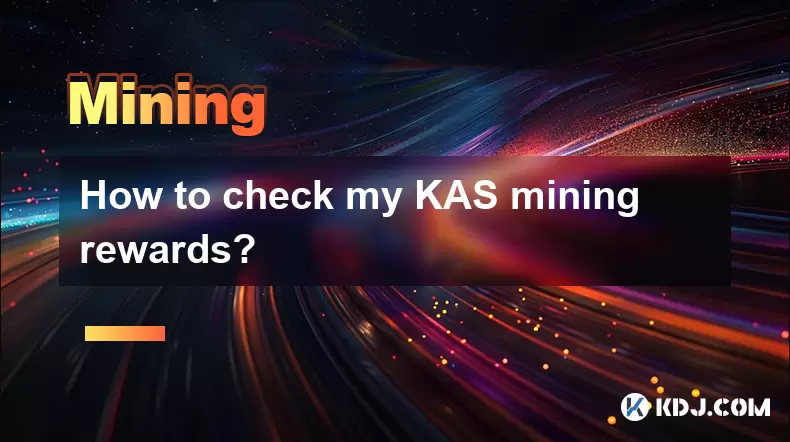-
 bitcoin
bitcoin $122659.385674 USD
0.52% -
 ethereum
ethereum $4484.113342 USD
-0.09% -
 bnb
bnb $1304.229256 USD
-0.85% -
 tether
tether $1.000204 USD
-0.03% -
 xrp
xrp $2.860636 USD
-0.51% -
 solana
solana $227.288799 USD
2.36% -
 usd-coin
usd-coin $0.999805 USD
0.01% -
 dogecoin
dogecoin $0.252837 USD
1.18% -
 tron
tron $0.341149 USD
1.12% -
 cardano
cardano $0.830507 USD
0.33% -
 hyperliquid
hyperliquid $45.792319 USD
0.04% -
 chainlink
chainlink $22.422164 USD
1.55% -
 ethena-usde
ethena-usde $1.000283 USD
0.01% -
 sui
sui $3.511389 USD
0.83% -
 stellar
stellar $0.385276 USD
-0.44%
How to check my KAS mining rewards?
Check your KAS mining rewards via the pool dashboard, block explorer, or wallet—ensure correct address, hash rate, and payout threshold for accurate tracking.
Jul 24, 2025 at 07:08 am

Understanding KAS Mining Rewards
KAS refers to the native cryptocurrency of the Kaspa blockchain, a high-throughput, blockDAG (Directed Acyclic Graph) protocol designed to support fast and scalable transactions. Miners on the Kaspa network contribute computational power to secure the network and validate transactions. In return, they receive mining rewards in the form of KAS tokens. These rewards are distributed based on the miner’s contribution to the network’s total hash rate. To verify your earnings, you must interact with either a mining pool dashboard, a wallet interface, or a block explorer that supports Kaspa.
Connecting Your Miner to a Kaspa Mining Pool
To begin receiving KAS mining rewards, you must first connect your mining rig to a Kaspa mining pool. Mining pools aggregate hash power from multiple miners, increasing the chances of finding a block and distributing rewards proportionally. Popular Kaspa pools include k1pool, kaspa.poolbinance.com, and mine.kastra.com. When configuring your mining software (such as kawpowminer or GMiner), you will input the pool’s server address, your wallet address, and optionally a worker name.
- Download and install a compatible mining software for your hardware (GPU or ASIC).
- Open the configuration file or command-line interface.
- Enter the pool URL (e.g.,
stratum+tcp://k1pool.org:4444). - Input your Kaspa wallet address as the username.
- Set a worker name (e.g.,
rig1) to track performance. - Launch the miner and confirm connection via logs.
Once connected, the pool will begin recording your shares submitted and estimate your KAS earnings based on your hash rate.
Accessing Your Mining Pool Dashboard
After your miner is active, the most reliable way to check your KAS mining rewards is through the mining pool’s web dashboard. Each pool provides a user interface where you can view real-time statistics, including hash rate, pending rewards, and payout history. Access is typically granted via your wallet address or a registered account.
- Navigate to your chosen pool’s website (e.g.,
https://k1pool.org). - Enter your Kaspa wallet address in the search or login field.
- Press 'Search' or 'Login' to access your miner stats.
- View sections labeled 'Miner Info', 'Earnings', or 'Payouts'.
- Confirm that your reported hash rate matches your rig’s output.
- Check the 'Pending Balance' — this reflects unreleased rewards.
- Look for 'Auto-Payout Threshold' settings; rewards are sent only when this value is reached (e.g., 10 KAS).
Some pools allow email notifications or API access for automated monitoring. Ensure your wallet address is correct, as incorrect entries result in irreversible loss of rewards.
Verifying Transactions on a Kaspa Block Explorer
Even after a payout is processed by the pool, it’s essential to confirm the transaction on the blockchain. A Kaspa block explorer such as explorer.kaspa.org or kaspad.app allows you to search for your wallet address and view all incoming and outgoing transactions.
- Open a Kaspa-compatible block explorer in your browser.
- Paste your full wallet address into the search bar.
- Press 'Search' to load your transaction history.
- Look for entries with positive KAS amounts from known pool addresses.
- Click on a transaction to view block height, timestamp, and confirmation status.
- Confirm the number of confirmations — typically, 10+ confirmations indicate finality.
If a payout appears in the pool dashboard but not on the block explorer, it may still be in the mempool or delayed due to network congestion. Always cross-reference both sources.
Using a Kaspa Wallet to Monitor Balance
To fully manage and verify your KAS mining rewards, you need a secure wallet. Official options include the Kaspa Command Line Wallet (kaspawallet), Specter Wallet, or Katana Wallet (browser extension). These tools let you import your private key or seed phrase and monitor your balance in real time.
- Download and install a trusted Kaspa wallet application.
- Create a new wallet or import an existing one using your 24-word seed phrase.
- Ensure your wallet is synced with the Kaspa network (this may take time).
- Once synced, your current KAS balance will be displayed.
- Compare this balance with your mining pool’s payout records.
- Enable transaction notifications if available.
Wallets also let you initiate transfers, check UTXO (Unspent Transaction Output) details, and verify incoming rewards directly on-chain. Never share your seed phrase or private key.
Troubleshooting Missing or Incorrect Rewards
If your KAS mining rewards do not appear as expected, several issues could be at play. First, verify that your miner is connected to the correct pool and submitting valid shares. Check the miner’s log output for errors like 'rejected shares' or 'connection timeout'. Rejected shares do not contribute to rewards.
- Confirm your wallet address is correctly formatted (starts with
kaspa:). - Ensure the pool supports auto-payouts and your balance exceeds the threshold.
- Review the pool’s payout schedule — some only disburse every 24 hours.
- Search the block explorer using your address to confirm no transactions were sent.
- Contact the pool’s support team with your wallet address and timestamps.
Network delays, incorrect configurations, or temporary pool outages can delay rewards. Persistent issues may require switching pools or updating mining software.
Frequently Asked Questions
How often are KAS mining rewards distributed by pools?Reward distribution frequency depends on the mining pool. Some pools like k1pool offer near-instant payouts once your balance reaches the minimum threshold (e.g., 1 KAS), while others may disburse rewards hourly or daily. Check your pool’s 'Payout Policy' section for exact timing and thresholds.
Can I track my KAS mining rewards without a wallet?Yes, you can use a mining pool dashboard with just your wallet address to view estimated earnings and pending rewards. However, to confirm actual receipt of funds, you must use a block explorer or a Kaspa wallet that connects to the blockchain.
Why does my pool show a balance but my wallet shows zero?This usually means the pool has not yet triggered a payout. Mining pools only send funds when your pending balance meets the minimum payout threshold. Additionally, network sync delays in lightweight wallets can cause temporary balance discrepancies.
What should I do if my rewards are sent to the wrong address?If you entered an incorrect wallet address in your miner configuration, the rewards are permanently lost, as blockchain transactions cannot be reversed. Always double-check your address before starting to mine. Use a test connection with a small hash rate to verify payouts before full deployment.
Disclaimer:info@kdj.com
The information provided is not trading advice. kdj.com does not assume any responsibility for any investments made based on the information provided in this article. Cryptocurrencies are highly volatile and it is highly recommended that you invest with caution after thorough research!
If you believe that the content used on this website infringes your copyright, please contact us immediately (info@kdj.com) and we will delete it promptly.
- Charlie Lee, Litecoin, and Regret: A NY Perspective
- 2025-10-10 00:45:15
- Cryptocurrencies, Bitcoin, & Market Analysis: Navigating the New Financial Landscape
- 2025-10-10 00:45:15
- Algorand, Chainlink, and BlockDAG: Navigating the Crypto Landscape in 2025
- 2025-10-10 00:50:12
- Polymarket's POLY Token: Hype or the Next Big Thing?
- 2025-10-10 00:50:12
- Whitelist, Crypto, Utility: Decoding the Hottest Trends in Web3
- 2025-10-10 00:25:15
- Aster Price, Binance Fund, and Ecosystem Growth: What's the Buzz?
- 2025-10-10 00:25:15
Related knowledge

The difference between staking and mining
Sep 24,2025 at 05:18am
Understanding Staking in the Cryptocurrency Ecosystem1. Staking involves holding funds in a cryptocurrency wallet to support the operations of a block...

How to participate in testnet mining?
Sep 22,2025 at 09:18am
Understanding Testnet Mining in the Crypto Ecosystem1. Testnet mining is a method used by blockchain developers to simulate real-world conditions on a...

How to dispose of abandoned mining machines?
Sep 19,2025 at 08:19pm
Assessing the Condition of Abandoned Mining Rigs1. Begin by inspecting each mining machine for visible damage, corrosion, or missing components. Machi...

How to identify high-quality mining pools?
Sep 21,2025 at 03:19pm
Reputation and Track Record1. A mining pool’s reputation is built over time through consistent performance and transparency. Pools that have operated ...

Advantages of decentralized mining pools
Sep 20,2025 at 04:36pm
Enhanced Security and Resistance to Censorship1. Decentralized mining pools operate on blockchain-based smart contracts, eliminating the need for a ce...

What is mining machine overclocking?
Sep 21,2025 at 07:19pm
Understanding Mining Machine Overclocking1. Mining machine overclocking refers to the process of increasing the operating frequency of a cryptocurrenc...

The difference between staking and mining
Sep 24,2025 at 05:18am
Understanding Staking in the Cryptocurrency Ecosystem1. Staking involves holding funds in a cryptocurrency wallet to support the operations of a block...

How to participate in testnet mining?
Sep 22,2025 at 09:18am
Understanding Testnet Mining in the Crypto Ecosystem1. Testnet mining is a method used by blockchain developers to simulate real-world conditions on a...

How to dispose of abandoned mining machines?
Sep 19,2025 at 08:19pm
Assessing the Condition of Abandoned Mining Rigs1. Begin by inspecting each mining machine for visible damage, corrosion, or missing components. Machi...

How to identify high-quality mining pools?
Sep 21,2025 at 03:19pm
Reputation and Track Record1. A mining pool’s reputation is built over time through consistent performance and transparency. Pools that have operated ...

Advantages of decentralized mining pools
Sep 20,2025 at 04:36pm
Enhanced Security and Resistance to Censorship1. Decentralized mining pools operate on blockchain-based smart contracts, eliminating the need for a ce...

What is mining machine overclocking?
Sep 21,2025 at 07:19pm
Understanding Mining Machine Overclocking1. Mining machine overclocking refers to the process of increasing the operating frequency of a cryptocurrenc...
See all articles


























![🚨IS VECHAIN (VET) A DEAD COIN ?? PRICE ANALYSIS [GET READY NOW] 🚨IS VECHAIN (VET) A DEAD COIN ?? PRICE ANALYSIS [GET READY NOW]](/uploads/2025/10/09/cryptocurrencies-news/videos/vechain-vet-dead-coin-price-analysis-ready/68e7b200b067b_image_500_375.webp)















































